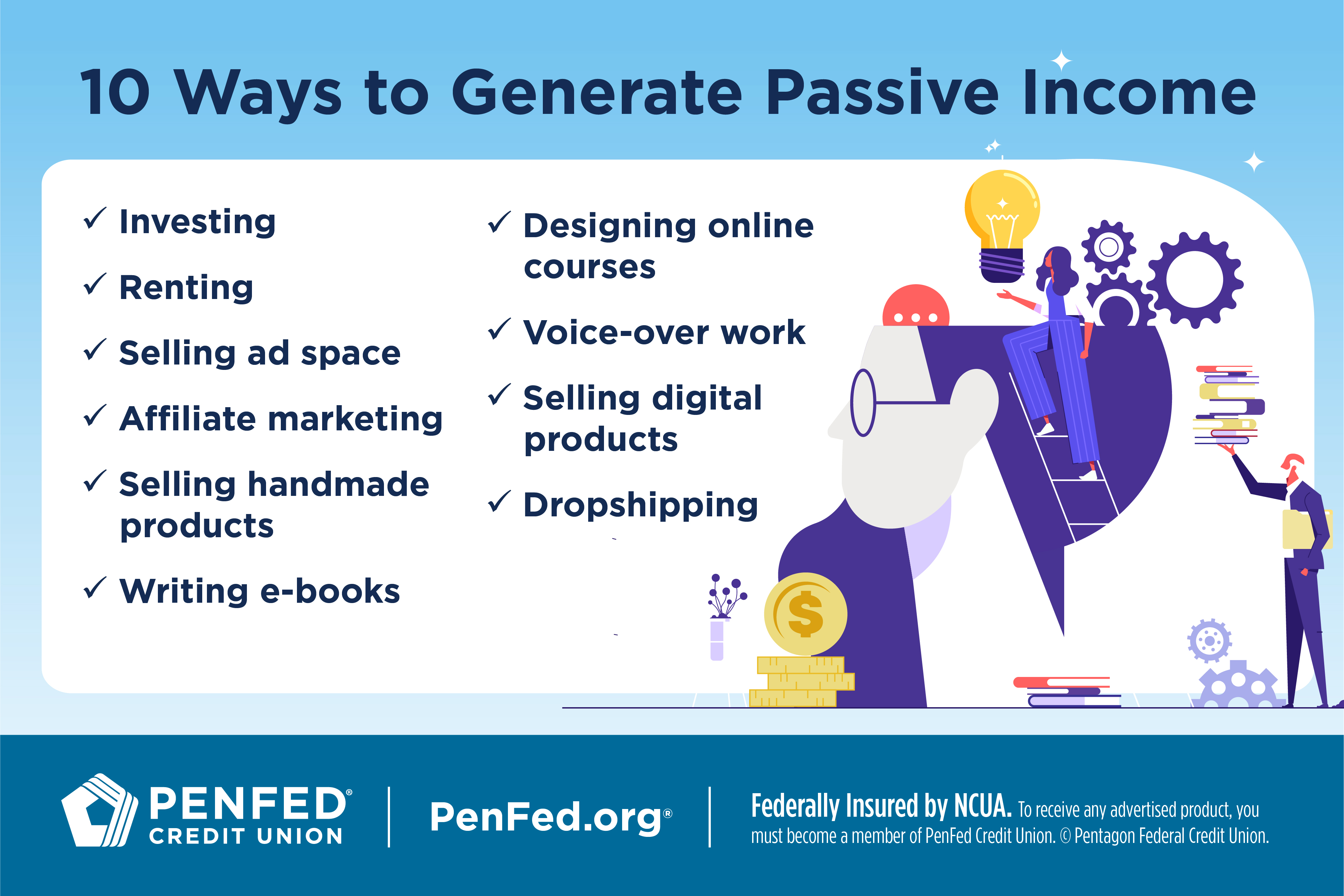Checking/Saving
10 Ways to Generate Passive Income
Expected read time: 8 minutes
Passive income is money you earn in addition to your primary salary and without much effort. The name “passive income” may sound like easy money, but that’s not always the case at first. Some sources of passive income take a lot of upfront work before reaching their full potential after months or years of work. But the right passive income source could offer a big payout in the long-term. Here are some passive income sources to consider.

1. Investing
High-Yield Savings Accounts
A savings account is a great way to start investing. You can start with very little money (the minimum at PenFed is $5), there’s no risk you’ll lose your investment, and it’s easy — you can even automate your savings. And as a liquid asset, you can tap into it whenever you need to avoid debt or reach financial goals, all while earning interest. The only downside is yields are lower on savings accounts than most other investments.
Bonds are a type of loan you make to a government or business that they pay back with interest over time.
Bonds and Bond Index Funds
Bonds are a type of loan you make to a government or business that they pay back with interest over time. Bonds are one of the safer investments you can make, but the tradeoff is they usually earn less than other investments and can take much longer to mature. For instance, federal series EE bonds take 20 years to mature and I Bonds take 30 years.
Dividend Stocks
With dividend stocks, you to buy shares of a company and receive payouts at regular periods (usually quarterly). Choosing the right stocks can be challenging, but once your money’s invested, your work is done. Stocks have the potential to earn faster than savings accounts, but they can stress you out more because they can also lose value quickly. Do your research and remember investing is a long game — highs and lows are inevitable.
Do your research and remember investing is a long game — highs and lows are inevitable.
Dividend Index Funds and Exchange Traded Funds (ETFs)
Index funds and exchange traded funds (ETFs) can be even simpler than dividend stocks. Instead of choosing each stock you invest in, you can invest in a collection of stocks. These collections of stocks usually outperform individual stocks and are less risky. However, they also gain value more slowly and often have smaller short-term payouts.
Real Estate Investment Trust (REIT)
You don’t have to buy a whole house or apartment building to get into real estate. If you have $500, you can put it into a real estate investment trust (REIT) and invest in different real estate properties similar to buying a share of a stock. You’ll earn rental income, which will increase as your real estate assets increase. Just make sure you do your homework to avoid scams and properties that are poor investments.
|
Type of Investment |
Yield |
Difficulty |
Risk |
Cost to Start Investing |
Liquidity |
|---|---|---|---|---|---|
|
High-yield Savings Accounts |
Low |
Low |
None |
Very low |
Highly liquid |
|
Bonds and Bond Index Funds |
Low |
Low |
None |
Low |
Illiquid |
|
Dividend Stocks |
Very low to very high |
Medium to high |
High |
Medium to high |
Highly liquid |
|
Dividend Index Funds and Exchange Traded Funds (ETFs) |
Low to high |
Low |
Low |
Low to medium |
Highly liquid |
|
Real Estate Investment Trust |
Low to very high |
Medium to high |
Medium |
Low to high |
Highly liquid |
Just make sure you do your homework to avoid scams and properties that are poor investments.
2. Renting Out Your Property
Whether or not you have a background in sales or interior design, marketing your property is crucial to standing out on rental sites. Look through comparable listings to get an idea of your competition and if necessary, enlist friends or family to help you style, photograph, and describe your rental. Who do you know with an English degree or a killer Instagram?
If you can’t afford to buy a property to rent, you can rent out your house while on vacation or traveling for work.
Your House
If you can’t afford to buy a property to rent, you can rent out your house while on vacation or traveling for work using short-term rental sites like Airbnb. You’re also taking a risk by renting to strangers, but depending on your location, you could make good money for little work.
Part of Your House
Even if you don’t want to rent your whole house, you can still use your house to make money by renting out part of it. Got a furnished attic, garage apartment, or unused bedroom? It might be just what someone’s looking for, either long-term or for a weekend away.
Your Car
Like with renting your home, renting your car out to strangers involves risk. But some people will pay well to borrow your car for a day or two. You can list your car on peer-to-peer carsharing websites to find customers. Just remember that extra driving will require extra maintenance.
3. Selling Ad Space
Consider contacting specialized marketing agencies about selling ad space on your car.
4. Affiliate Marketing
Affiliate marketing is competitive, and you’ll need to have a good following to generate much income, but there’s very little work involved beyond what you’re already doing.
Affiliate marketing is competitive, and you’ll need to have a good following.
5. Selling Handmade Products
Print-on-Demand Store
With print-on-demand, you choose a company to work with and create a digital store on their platform. Upload your original artwork to their website and customers will choose a design and product they want printed with the design (think notebooks, T-shirts, water bottles, and more). Then the print-on-demand company will create and ship the product, taking a cut off the top and giving you the rest.
With print-on-demand, you choose a company to work with and create a digital store on their platform.
Music Licensing
You can license your original music through stock music sites. Your songs could go on to feature in commercials or videos all over the web — and you could be paid each time that happens for years to come.
6. Writing e-Books
Many self-publishing sites don’t charge upfront fees, instead taking a cut of your sales so the cost to entry is low. Competition can be fierce, though. Depending on the type of books you write, your upfront workload could be intense. You may also need to pay someone to edit your writing or commission artwork before you’re ready to publish.
Creating an online video or audio course could be a way to capitalize on any special expertise or skills you have.
7. Designing Online Courses
8. Voice-over Work
The demand for voice-over work is increasing along with the rise of video and audio content online. More and more companies are using podcasts, YouTube videos, and social media shorts to reach their audiences, and they all require a good set of pipes to get their message across. Many publishing companies also hire voice talent to meet the increasing demand for audio books. You can either buy a few startup tools yourself, or you can find a company to provide audio equipment for you to use in the comfort of your own home.
Many publishing companies also hire voice talent to meet the increasing demand for audio books.
9. Selling Digital Products
Digital products cost little to make and don’t need to be prepared or shipped, giving them a high profit margin. And once created, each item can be sold hundreds or thousands of times. There are also lots of product types you can sell, including:
- Spreadsheets and budgeting documents
- Design tools
- Reference guides
- Lesson plans and worksheets
- Templates, patterns, and printables
- Recipes and meal plans
- Workout plans
- Apps and plug-ins
Besides making the product, you’ll need to either find an existing website or create your own where you can sell your products.
10. Dropshipping
The Takeaway
Passive income is a great way to boost your savings, supplement your retirement, build personal wealth, or protect your family during hard times. It can even cover fun extras like vacations or your dream car. Now that you know how to get started, what are you going to do with your extra dough?
Checking Made Simple
Get access to a checking account built for the way you live.




